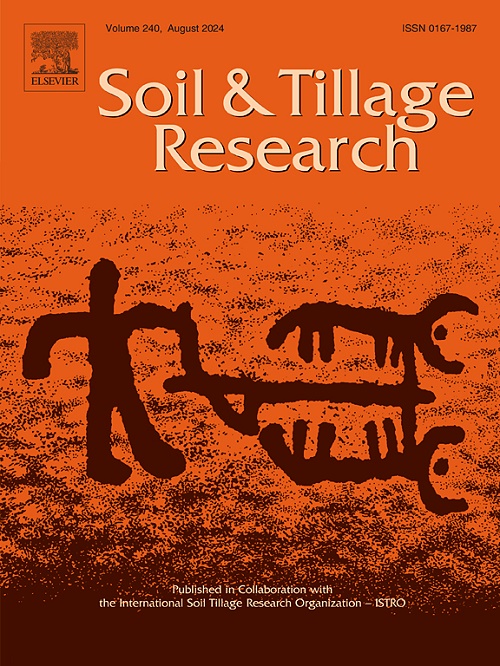通过钾平衡确定华北冬小麦-夏玉米轮作系统中最优产量、钾利用效率和土壤肥力的关键钾投入
IF 6.1
1区 农林科学
Q1 SOIL SCIENCE
引用次数: 0
摘要
钾是植物生长的主要限制性常量营养素。不适当的施钾决定会导致产量和钾利用效率(KUE)的降低。鉴于钾资源的稀缺性和不可再生性,制定关键钾投入指标至关重要。表观钾平衡是根据肥料投入和作物钾吸收计算的简化方法,可以进行直接的农艺评估。在这里,我们假设表观钾平衡是确定临界钾输入的一个有价值的指标。通过12年6个钾处理(0、30、60、90、120和150 kg K hm - 1 /年)的大田试验,评估了华北地区冬小麦-夏玉米轮作体系中籽粒产量对表观钾平衡的响应,建立了钾投入产出框架,并确定了临界钾投入。随着施钾量的增加,作物产量、钾吸收量和钾肥回收效率先升高后降低,这可能是钾过量导致的养分失衡和盐胁迫所致。钾平衡阈值可以根据要追求的目标产量来确定。钾平衡为0 -9.77 kg K hm - 1 /年,可获得最佳产量并保持土壤肥力。K输入-输出框架提供了K平衡和KUE关系的清晰可视化。在56.6 ~ 62.5 kg K hm - 1的临界施钾量范围内,土壤速效钾和有机质保持较高水平,速效钾利用率提高到85% ~ 100% %。总体而言,在适当的钾平衡阈值范围内优化钾投入,可以同时提高作物产量、钾肥利用率和土壤质量。该研究为确定关键钾平衡和钾输入提供了新的见解,为田间钾管理提供了指导。本文章由计算机程序翻译,如有差异,请以英文原文为准。
Identifying the critical potassium inputs for optimum yield, potassium use efficiency and soil fertility through potassium balance in a winter wheat-summer maize rotation system in North China
Potassium (K) is a primary limiting macronutrient for plant growth. Inappropriate K application decisions can lead to reduced yield and potassium use efficiency (KUE). Given the scarcity and non-renewable nature of K resources, developing an indicator for critical K input is essential. The apparent K balance is a simplified method calculated from fertilizer inputs and crop K uptake, enabling straightforward agronomic evaluation. Here, we hypothesize that the apparent K balance serves as a valuable indicator for determining critical K input. A twelve-year field trial with six K treatments (0, 30, 60, 90, 120, and 150 kg K ha–1 per year) was conducted to assess grain yield response to apparent K balance, establish a K input-output framework, and determine critical K input in a winter wheat-summer maize rotation system in North China. The crop yield, K uptake, and K fertilizer recovery efficiency initially increased but then declined with increasing K fertilizer rates, likely due to excessive K-induced nutrient imbalance and salt stress. The K balance threshold can be determined based on the target yield to be pursued. A K balance of 0 –9.77 kg K ha–1 per year achieved optimal yield and maintained soil fertility. The K input-output framework provided a clear visualization of the K balance and KUE relationships. The critical K input range of 56.6 –62.5 kg K ha–1 achieved high yields with KUE improving to 85 –100 %, while sustaining high levels of soil available K and organic matter. Overall, optimizing K input within appropriate K balance thresholds enhances crop yield, KUE and soil quality simultaneously. This study provides new insights for determining critical K balance and K input, offering guidance for field-scale K management.
求助全文
通过发布文献求助,成功后即可免费获取论文全文。
去求助
来源期刊

Soil & Tillage Research
农林科学-土壤科学
CiteScore
13.00
自引率
6.20%
发文量
266
审稿时长
5 months
期刊介绍:
Soil & Tillage Research examines the physical, chemical and biological changes in the soil caused by tillage and field traffic. Manuscripts will be considered on aspects of soil science, physics, technology, mechanization and applied engineering for a sustainable balance among productivity, environmental quality and profitability. The following are examples of suitable topics within the scope of the journal of Soil and Tillage Research:
The agricultural and biosystems engineering associated with tillage (including no-tillage, reduced-tillage and direct drilling), irrigation and drainage, crops and crop rotations, fertilization, rehabilitation of mine spoils and processes used to modify soils. Soil change effects on establishment and yield of crops, growth of plants and roots, structure and erosion of soil, cycling of carbon and nutrients, greenhouse gas emissions, leaching, runoff and other processes that affect environmental quality. Characterization or modeling of tillage and field traffic responses, soil, climate, or topographic effects, soil deformation processes, tillage tools, traction devices, energy requirements, economics, surface and subsurface water quality effects, tillage effects on weed, pest and disease control, and their interactions.
 求助内容:
求助内容: 应助结果提醒方式:
应助结果提醒方式:


